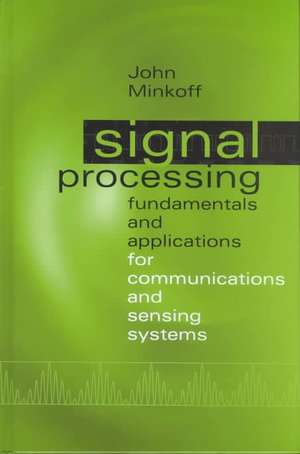Signal Processing Fundamentals and Applications for Communications and Sensing Systems: Artech House Signal Processing Library
Autor John R. Minkoff, John Minkotten Limba Engleză Hardback – 31 iul 2002
Preț: 733.70 lei
Preț vechi: 894.76 lei
-18% Nou
Puncte Express: 1101
Preț estimativ în valută:
140.41€ • 152.46$ • 117.94£
140.41€ • 152.46$ • 117.94£
Carte indisponibilă temporar
Doresc să fiu notificat când acest titlu va fi disponibil:
Se trimite...
Preluare comenzi: 021 569.72.76
Specificații
ISBN-13: 9781580533607
ISBN-10: 1580533604
Pagini: 308
Dimensiuni: 162 x 234 x 25 mm
Greutate: 0.64 kg
Ediția:New.
Editura: Artech House Publishers
Seria Artech House Signal Processing Library
ISBN-10: 1580533604
Pagini: 308
Dimensiuni: 162 x 234 x 25 mm
Greutate: 0.64 kg
Ediția:New.
Editura: Artech House Publishers
Seria Artech House Signal Processing Library
Cuprins
Preface. Introduction -- Fundamentals of Receivers. Review of Probability -- Bernoulli Trials, The Binomial Distribution. The Poisson Distribution. The Exponential Distribution. The Gaussian Distribution. The Rayleigh and Rice Distributions. Joint Distributions, Conditional Distributions and Bayes’ Theorem. Characteristic Functions. The Law of Large Numbers. The Central Limit Theorem. Approximations to the Gaussian Distribution. Functions of a Random Variable. Review of Noise and Random Processes -- Introduction. Correlation Functions and Power Spectral Densities. Types of Noise. Power Spectral Density of Thermal Noise – Nyquist’s Theorem. Power Spectral Density of Shot Noise. Shot Noise and Optical Receivers - the Quantum Limit. Noise Statistics, Shot Noise in Radio Frequency and Optical systems. Noise Figure and Noise Temperature. Noise Figure of an Attenuator. Applications: Noise Power Measurements, Signal to Noise Ratio. Connections with Statistical Physics. Continuous and Discrete-Time Signals -- The Sampling Theorem and Oversampling. The Sampling Theorem for Bandpass Carrier Signals. Signal Duration and Bandwidth. The Analytic Signal. Processing of Continuous and Discrete-Time Signals. Detection of Signals in Noise -- Statistical Decision Theory: The Likelihood Ratio Test. Decision Criteria, Bayes, Maximum Likelihood, Neyman-Pearson. Implementation of Decision Criteria. Correlation Detection: The Matched Filter-I. The Gaussian Channel, The Shot Noise Channel. The Matched Filter-II. Coherent and Noncoherent Detection and Processing -- Ideal Noncoherent Detection of a Single Pulse. Comparison of Coherent and Noncoherent Detection of a Single Pulse. Improvement in Signal-to-Noise Ratio by Coherent and Noncoherent Integration. Performance of Coherent and Noncoherent Integration. Summary of Coherent and Noncoherent Detection and Processing. Parameter Estimation and Applications -- Estimation of Range to a Target. Generalized ParameteEstimation – The Cramer – Rao Lower Bound. Applications of Maximum Likelihood Estimation to Sensor Measurements. Application of Parameter Estimation to Tracking and Prediction. Waveform Analysis. Range-Doppler Resolution and Ambiguity -- The Generalized Ambiguity Function. Large Time-Bandwidth Waveforms -- Chirp Waveforms and Pulse Compression. Doppler Invariant Properties of Chirp Waveforms. Hyperbolic Frequency Modulation. Ambiguity Function for Large BT Waveforms. Coded Waveforms. Generalized Coherent and Noncoherent Detection and Processing Using Arbitrary Complex Signals – Noncoherent and Coherent Detection of a Single Pulse. Coherent and Noncoherent Integration. Systems Considerations -- Beampatterns and Gain of Antennas and Arrays. The Radar and Sonar Equations. The Search Problem. Specification of the False-Alarm Probability. Appendix. Table of Values the Error Function. References. Index.








